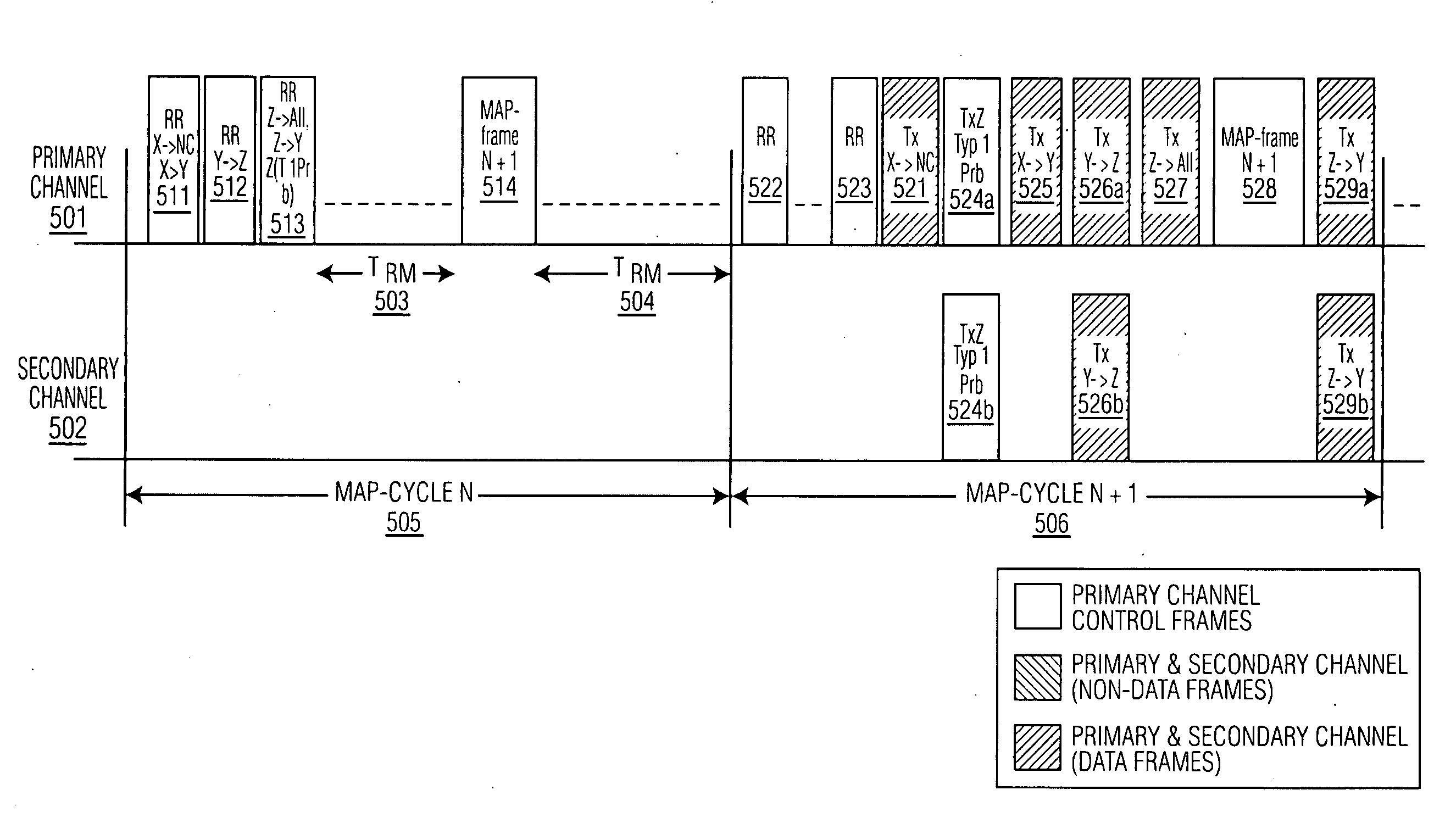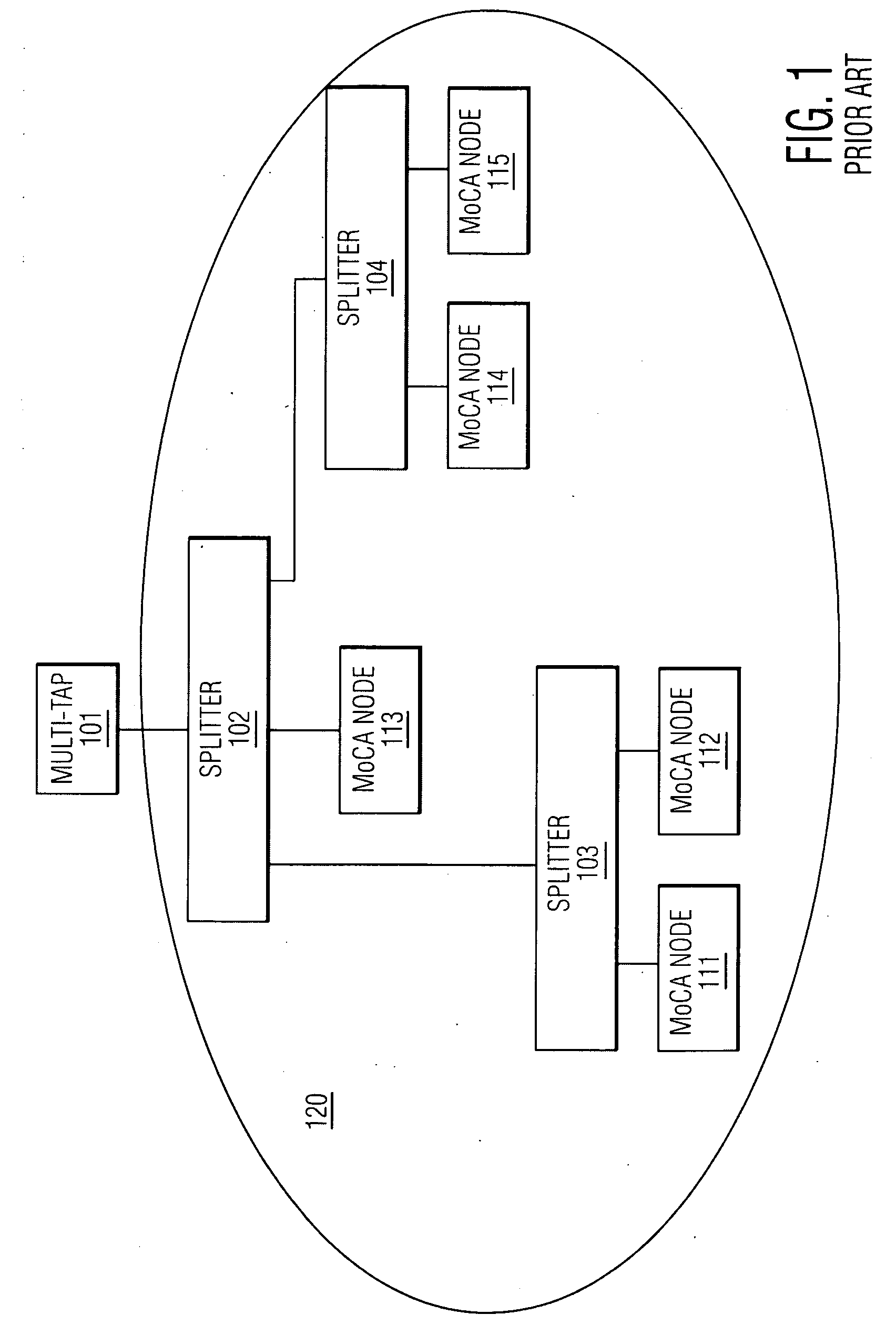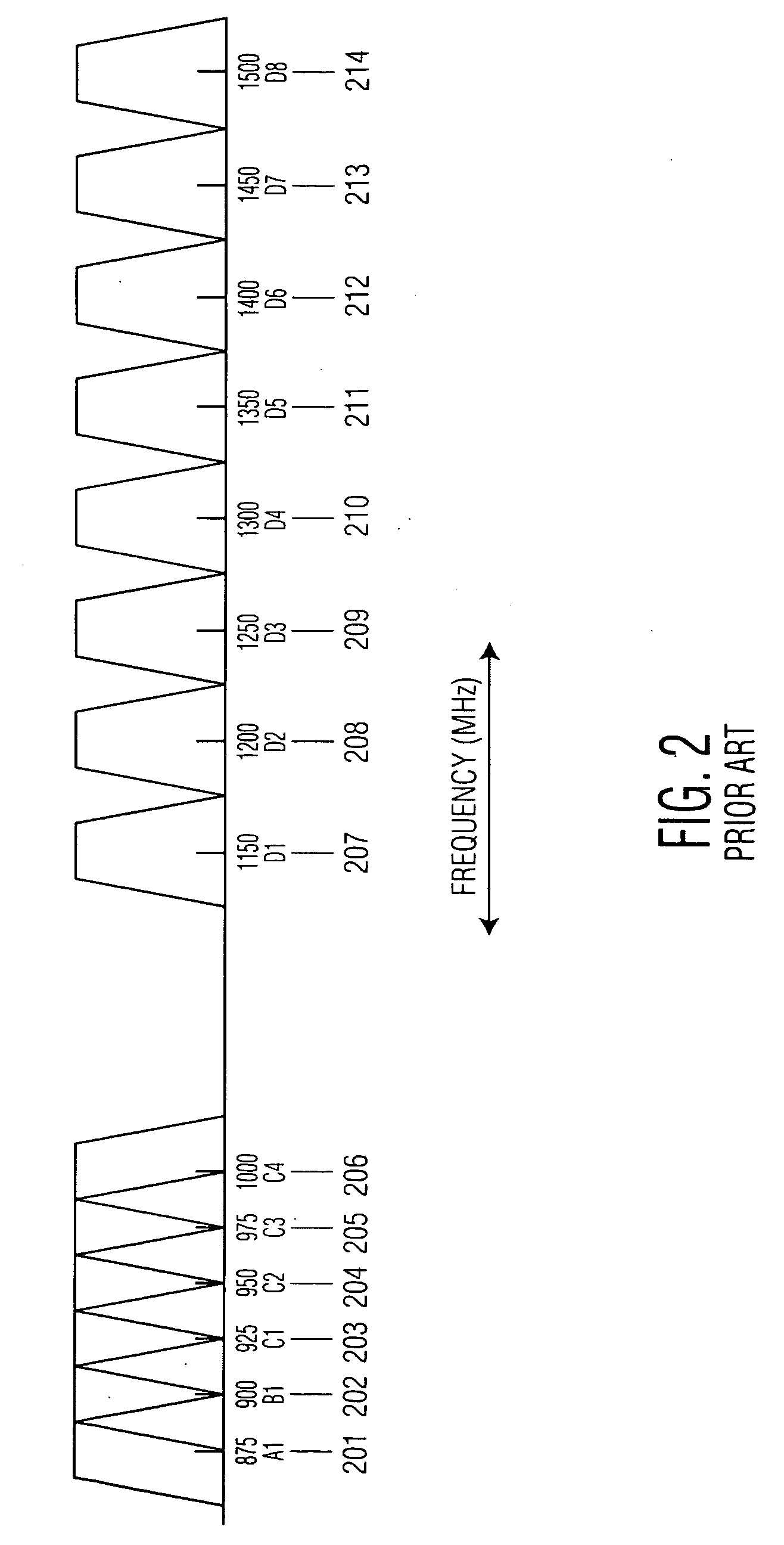[0017]Deficiencies in the prior systems are addressed by the present invention. Embodiments include a method augmenting communications on a primary channel through means of additional secondary channels for the purposes of increasing overall data-rate, enhancing reliability, reducing transmit power and extending range, such method comprising the steps of configuring EMoCA capable nodes to use the secondary channels; marking the configured secondary channels in a
list of unusable channels with the purpose of signaling legacy-nodes not capable of EMoCA communications to avoid transmission on unusable channels; signaling by the configured nodes, via the network controller of their capability to use secondary channels; determining by EMoCA capable nodes through broadcast of capability information by the network controller and utilizing the maximal set of common secondary channels when communicating with other such nodes; receiving by EMoCA capable nodes all scheduling information via the schedule broadcast by the network controller on the primary channel; determining by EMoCA capable nodes transmission parameters for use on the secondary channels as per the methods adopted on the primary channel and transmitting similar
channel sounding packets on the secondary channels; receiving by EMoCA capable nodes,
channel sounding packets,
processing them and transmitting their response via the primary channel; realizing by the EMoCA capable nodes optimal channel utilization by maintaining
equal time occupancy on primary and secondary channels; transmitting by the EMoCA capable nodes at high data rates by splitting a
payload to occupy the minimum number of transmission symbols across both primary and secondary channels; realizing by the EMoCA capable nodes high reliability transmission by replicating a
payload on both primary and secondary channels; realizing by the EMoCA capable nodes high reliability transmission by repeating the
payload by a factor prior to splitting it across primary and secondary channels as per the embodiments of the present invention; and realizing by the EMoCA capable nodes high reliability, low transmit power and extended range transmissions by reducing the
constellation order in transmissions. Additionally, the configuring step may also be based on a previously-determined and commonly-known relationship of the secondary channel with respect to the primary channel.
[0018]Legacy nodes may be prevented from accessing a secondary channel by an EMoCA node marking the secondary channel as an unusable channel in its
list of unusable channels; communicating its
list of unusable channels to the network controller; and having the network controller periodically broadcast the union of the set of all unusable channels as told to it by nodes requesting the network controller access to the network, with the legacy nodes receiving this broadcast from the network avoiding accessing any unusable channel.
[0026]In addition to the method and variants thereof, embodiments of the present invention further includes apparatuses for augmenting communications on a primary channel through the use of additional secondary channels for the purposes of increasing overall data-rate, enhancing reliability, reducing transmit power and extending range. The apparatus can comprise an
application processor capable of either exposing a generic
network interface to an external device or serving as a source or sink for data to be transacted over the communications network; a
media access control processor capable of independently and simultaneously controlling the primary and secondary channel
physical layer processors; a memory unit used for storing packets; a primary physical-layer processor capable of transmitting and receiving a bit
stream from the
media access control processor an appropriate intermediate
signal-type as input to a front-end device; a plurality of secondary physical-layer processors capable of transmitting and receiving a bit
stream from the
media access control processor an appropriate intermediate
signal-type as input to a front-end device; a plurality of front-end devices each connected to its respective physical-layer processor, each capable of translating the intermediate
signal-type of the physical-layer processor to the modulated waveform at the appropriate channel frequency, to be transmitted on the channel medium; a combining device capable of combining the outputs of the front-end devices into a single
network interface; and a common
clock source generating the clocks to the claimed
media access control processor, physical-layer processors and front-end devices.
[0027]Another embodiment of the apparatus can comprise a plurality of devices each capable of communications over a single communications channel, inter-connected in a manner, such that a device designated as primary interfaces to an
application processor via one interface and to devices designated as secondary via another interface; network outputs of primary and secondary devices being interfaced to the
network media by means of a combiner; primary and secondary devices deriving their clocks from the same reference source. The primary and secondary devices can be synchronized by performing the steps of
polling by the primary device the status of the phase-locked loop of the secondary device via means of an inter-device interface; writing by the primary device, on determining the phase-locked loop of all primary and secondary devices as locked, a synchronization word to its own time-counter as well as to the time counters of the secondary devices over an inter-device interface, the synchronization word written to the secondary devices accounting for a pre-determined latency difference between the primary device accessing its
internal time-counter and the primary device accessing the time-counter of the secondary devices over the inter-device interface. This apparatus can also be booted by having the primary device perform the steps of accessing the
firmware image from an
external source and storing it in memory; transferring the boot-code to the secondary devices via the inter-device interface; and signaling the secondary devices on completion of the transfer of boot-code via the inter-device interface. Furthermore, the apparatus can utilize the
asymmetry between primary and secondary devices to realize a reduction in overall
power consumption by selectively disabling unused components on either device. This
asymmetry can further be exploited by reducing the
operating frequency of internal sub-modules of the component devices as a function of
processing load.
 Login to View More
Login to View More  Login to View More
Login to View More 


